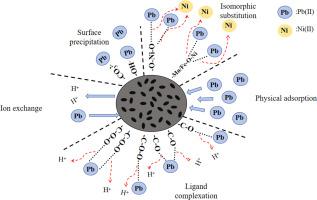Remediation of lead-contaminated soil by Fe-Mn-Ni layered double hydroxide composite biochar
IF 7.1
Q1 ENGINEERING, CHEMICAL
引用次数: 0
Abstract
This study investigated the remediation of lead (Pb)-contaminated soil using Fe-Mn-Ni layered double hydroxide composite biochar (LDH/CSB). The results demonstrated that LDH/CSB application significantly increased soil pH, electrical conductivity (EC), and total organic carbon (TOC) content. The elevation of soil pH enhanced Pb precipitation as insoluble hydroxides (e.g., Pb(OH)2), while increased TOC provided abundant oxygen-containing functional groups (e.g., carboxyl and hydroxyl groups) to immobilize Pb through complexation and surface adsorption. The high specific surface area (up to 78.70 m²/g) and layered structure of LDH/CSB further facilitated Pb binding, transforming mobile fractions (acid-soluble and reducible Pb) into stable forms (oxidizable and residual Pb). Toxicity characteristic leaching procedure (TCLP) tests confirmed a 53.80 % reduction in Pb leachability, highlighting reduced bioavailability and ecological risks. This work underscores the potential of LDH/CSB as a sustainable and efficient material for Pb-contaminated soil remediation, with broader applications in heavy metal-polluted environments. Future studies should focus on optimizing field-scale application parameters and evaluating long-term stability.

铁锰镍层状双氢氧化物复合生物炭修复铅污染土壤的研究
研究了Fe-Mn-Ni层状双氢氧化物复合生物炭(LDH/CSB)对铅污染土壤的修复效果。结果表明,LDH/CSB施用显著提高了土壤pH、电导率和总有机碳含量。土壤pH的升高促进了Pb以不溶性氢氧化物(如Pb(OH)2)的形式析出,而TOC的增加提供了丰富的含氧官能团(如羧基和羟基),通过络合和表面吸附来固定Pb。LDH/CSB的高比表面积(高达78.70 m²/g)和层状结构进一步促进了Pb的结合,将流动组分(酸溶性和可还原性Pb)转化为稳定形态(可氧化性和残余Pb)。毒性特征浸出程序(TCLP)测试证实铅的浸出性降低了53.80%,突出了生物利用度和生态风险的降低。本研究强调了LDH/CSB作为一种可持续、高效的铅污染土壤修复材料的潜力,在重金属污染环境中具有更广泛的应用前景。未来的研究应侧重于优化现场规模应用参数和评估长期稳定性。
本文章由计算机程序翻译,如有差异,请以英文原文为准。
求助全文
约1分钟内获得全文
求助全文
来源期刊

Chemical Engineering Journal Advances
Engineering-Industrial and Manufacturing Engineering
CiteScore
8.30
自引率
0.00%
发文量
213
审稿时长
26 days
 求助内容:
求助内容: 应助结果提醒方式:
应助结果提醒方式:


